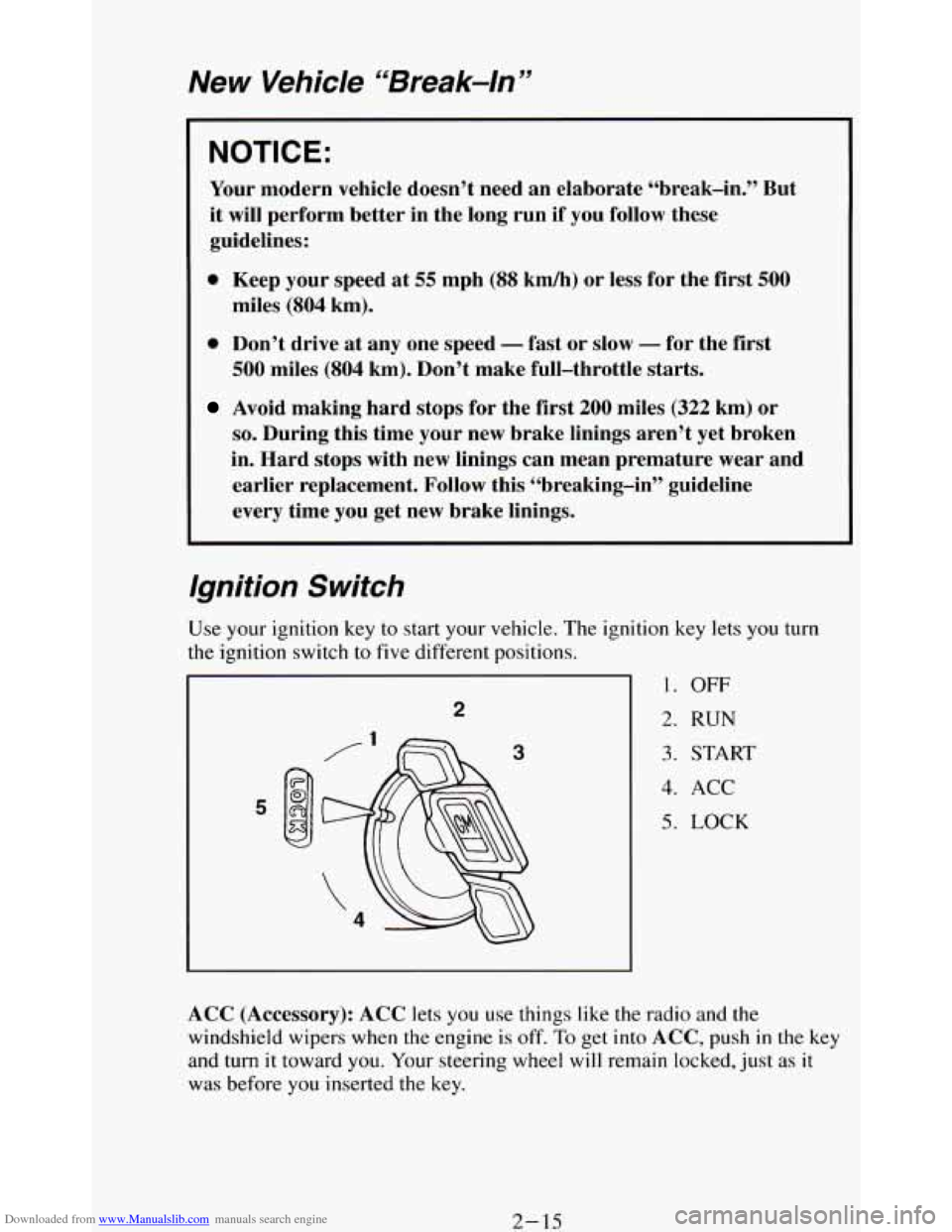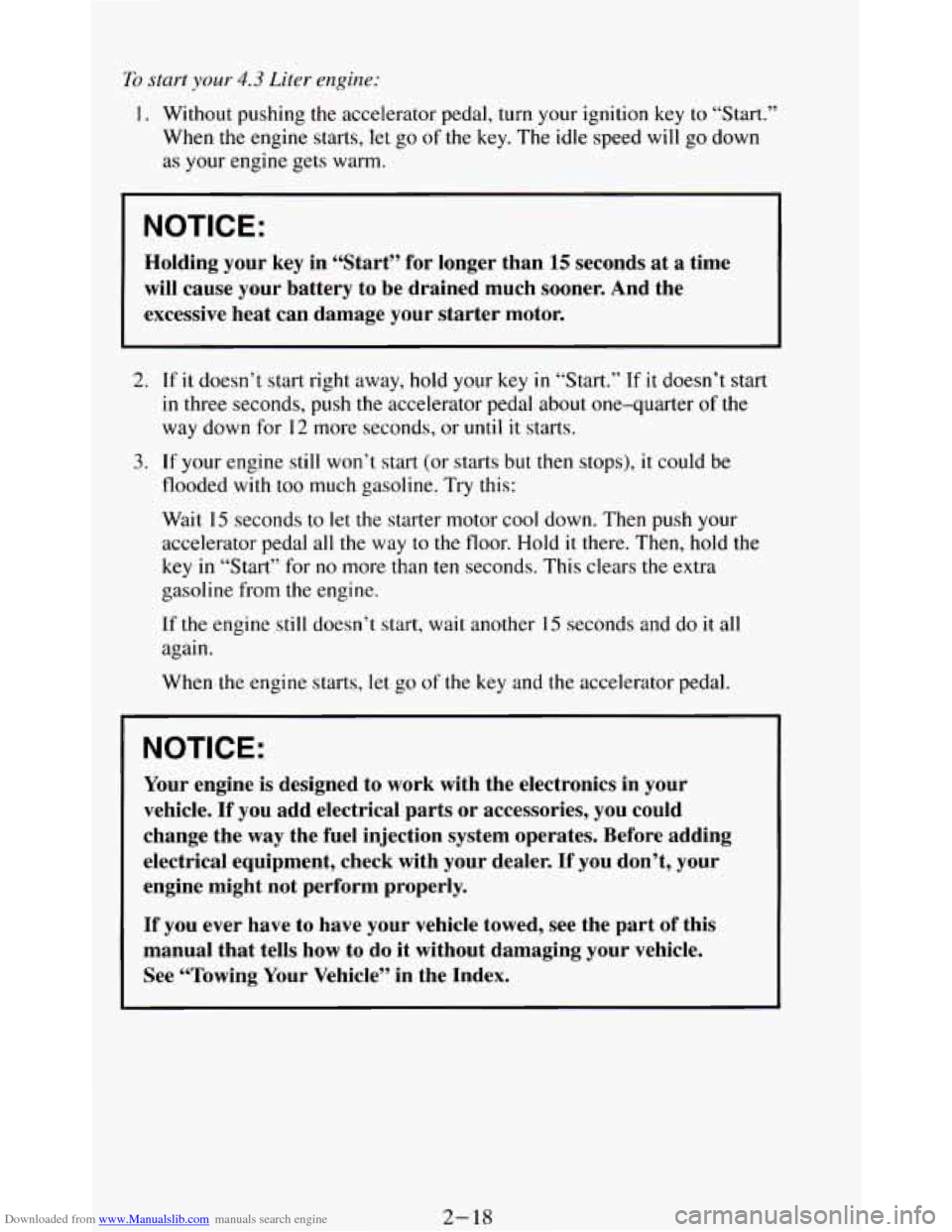Page 16 of 348
Downloaded from www.Manualslib.com manuals search engine Front Seatback Latches (Two-Door Models)
The front seatback folds forward to let people get into the back seat.
Reclining Front Seatbacks
(Bucket Seats
or 60/40 Split-Bench)
To fold a front
seatback forward,
push the seatback
toward the rear as you
lift this latch. Then the
seatback will fold
forward. The latch
must be down for the
seat to work properly.
To adjust the seatback,
lift the lever
on the
outer side of the seat.
Release the lever to lock the seatback
where you want it.
Pull up on the lever
I
and the seat will go to
4 an upright position.
1-4
Page 51 of 348
Downloaded from www.Manualslib.com manuals search engine Q: What if a child is wearing a lap-shoulder belt, but the child is so
small that the shoulder belt is very close to the child's face or neck?
A: Move the child toward the center of the vehicle, but be sure that the
shoulder belt still is on the child's shoulder,
so that in a crash the
child's upper body would have the restraint that belts provide.
If the
child is
so small that the shoulder belt is still very close to the child's
face or neck, you might want to place the child in a seat that has a lap
belt, if your vehicle has one.
1-39
Page 59 of 348
Downloaded from www.Manualslib.com manuals search engine Your Doors And How They Work
Side Doors
To open the door f~
the outside, lift the
handle and pull the
door open.
*om
To open the door from
the inside, pull the
lever toward you and
push the door open.
2-5
Page 61 of 348
Downloaded from www.Manualslib.com manuals search engine From the inside: To
lock the door, slide the
lever on your inside
I
Power Door Locks
door to LOCK.
To unlock the door,
slide the lever
on your
inside door toward
you. You will see a
red area
on the lever.
If your vehicle has
power door locks,
push the power door
lock switch on either
front door toward the
key symbol. This
switch will lock all the
doors
at once.
To unlock the doors,
push the switch away
from the key symbol.
On four-door models, the lever on each rear door works only that door’s
lock.
Leaving Your Vehicle
If you are leaving the vehicle, take your keys, open your door and set the
locks from inside. Then get out and close the door.
2-7
Page 64 of 348
Downloaded from www.Manualslib.com manuals search engine Endgate-Mounted Spare Tire Carrier
If your vehicle has a
endgate-mounted spare tire carrier, you
must move the carrier
arm out of the way to
open the glass.
You must move the
carrier arm out
of the
way
to open the
endgate glass. Here's
how
to move the arm:
1. Squeeze the release handle to free the carrier arm.
2. Swing the carrier arm away from the endgate. You may need to give it
a slight tug.
3. To latch the carrier arm, swing it toward the endgate. The latch has two
catches, so push on the carrier arm to make sure it has locked into the
second one. It shouldn't move.
2- 10
Page 69 of 348

Downloaded from www.Manualslib.com manuals search engine New Vehicle “Break-In ’’
L
NOTICE:
Your modern vehicle doesn’t need an elaborate “break-in.” But
it will perform better in the long run if you follow these
guidelines:
0 Keep your speed at 55 mph (88 km/h) or less for the first 500
miles (SO4 km).
0 Don’t drive at any one speed - fast or slow - for the first
500 miles (804 km). Don’t make full-throttle starts.
Avoid making hard stops for the first 200 miles (322 km) or
so. During this time your new brake linings aren’t yet broken
in. Hard stops with new linings can mean premature wear and
earlier replacement. Follow this “breaking-in” guideline
every time you get new brake linings.
Ignition Switch
tion key lets you turn
1. OFF
2. RUN
3. START
4. ACC
5. LOCK
ACC (Accessory): ACC lets you use things like the radio and the
windshield wipers when the engine is off.
To get into ACC, push in the key
and turn
it toward you. Your steering wheel will remain locked, just as it
was before you inserted the key.
2- 15
Page 72 of 348

Downloaded from www.Manualslib.com manuals search engine Tu start your 4.3 Liter engine:
1. Without pushing the accelerator pedal, turn your ignition key to “Start.”
When
the engine starts, let go of the key. The idle speed will go down
as your engine gets warm.
NOTICE:
Holding your key in “Start” for longer than 15 seconds at a time
will cause your battery to be drained much sooner. And the
excessive heat can damage your starter motor.
2. If it doesn’t start right away, hold your key in “Start.” If it doesn’t start
in three seconds, push the accelerator pedal about one-quarter of the
way down for
12 more seconds, or until it starts.
3. If your engine still won’t start (or starts but then stops), it could be
flooded with too much gasoline. Try this:
Wait
15 seconds to let the starter motor cool down. Then push your
accelerator pedal all the way to the floor. Hold it there. Then, hold the
key
in “Start” for no more than ten seconds. This clears the extra
gasoline from the engine.
If the engine still doesn’t start, wait another 15 seconds and do it all
again..
When
the engine starts, let go of the key and the accelerator pedal.
j ~ NOTICE:
, Your engine is designed to work with the electronics in your
vehicle. If you add electrical parts
or accessories, you could
change the
way the fuel injection system operates. Before adding
electrical equipment, check with your dealer. If you don’t, your
engine might not perform properly.
If you ever have to have your vehicle towed, see the part of this
manual that tells how
to do it without damaging your vehicle.
See “Towing Your Vehicle” in the Index.
2- 18
Page 75 of 348
Downloaded from www.Manualslib.com manuals search engine 1
R (Reverse) - Use this gear to back up.
NOTICE:
Shifting to “R” (Reverse) while your vehicle is moving forward
could damage your transmission. Shift to
“R” (Reverse) only
after your vehicle
is stopped.
To rock your vehicle back and forth to get out of snow, ice or sand
without damaging your transmission, see
“If You’re Stuck: In Sand,
Mud, Ice or Snow”
in the Index.
N (Neutral) - In this position, your engine doesn’t connect with the
wheels.
To restart when you’re already moving, use “N” (Neutral) only.
Also, use
“N’ (Neutral) when your vehicle is being towed.
2-21